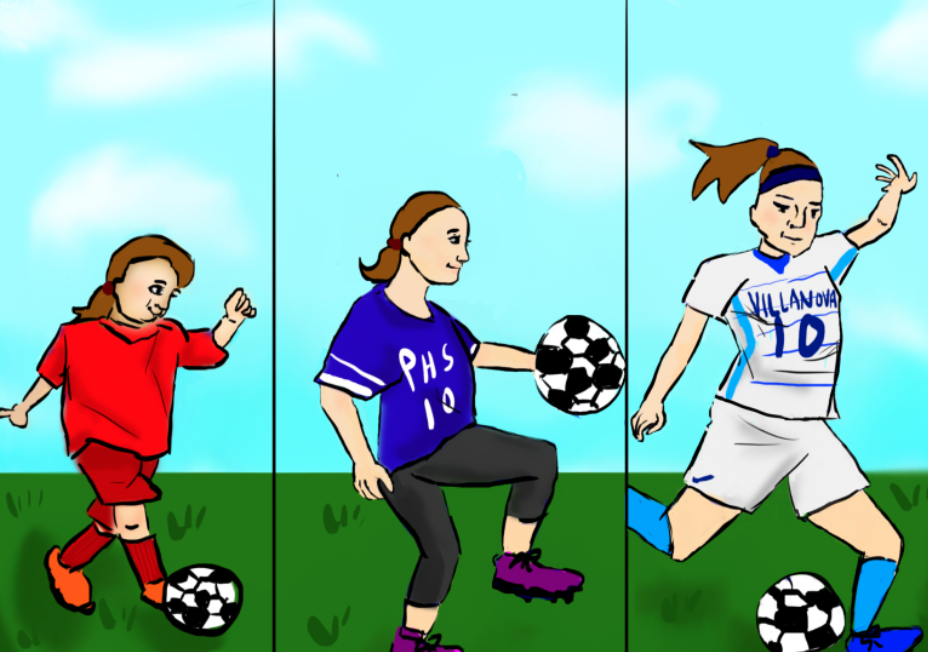Advice for future college athletes
March, 2021
As the end of the year approaches, senior athletes, who have either been recruited or are thinking about playing sports in the future, are excited to begin their athletic careers in college. However, high school and college sports differ in aspects such as intensity, competitiveness, teamwork, and coach relationships. To prepare the student athletes graduating this year, PHS alumni athletes offered their perspective on the differences between the high school and college.
Most high school athletes are excited to play sports in college because they are entering a new stage of their lives. As a college athlete, they are offered a chance to play with skilled players from all over the world. However, this opportunity comes with more responsibility and engagement. As a former captain of the PHS girls tennis team and a current player at Swarthmore, Spencer Watts ’20 attests that college sports are more intense.
“Practices definitely do feel more serious. We have quite a bit of practice. We had six [practices a week] during our offseason last semester, so basically practicing every day, except for Sunday. So I definitely had a lot more training, which was different from high school,” Watts said.
This difference in intensity most likely stems from both the variation in skill and difference in importance of sports. High school teams are made up of athletes with different ability levels, some athletes who simply follow their friends, while others who have played for 10 years. Contrastingly, college teams consist entirely of athletes who have a great deal of experience and have worked hard to reach the level they are currently at. In addition to the contrast in skill, colleges focus heavily on their sports teams, which mostly likely accounts for the increase in engagement. With their reputation reflecting on the success of their sports teams, colleges pay great attention to the state of their athletes. Amelia Whaley ’13, a former PHS and Lock Haven University cross country athlete, said that she was startled by the attention that sports received from the college.
“My university put a lot of funding into cross country. They would send out a bus with the name of the University on it. They would pay for us to get to the hotel the night before, we would have to dress up for the dinner before and when we got there, we did quite a post race. That, of course, makes it more serious because there's a greater chance of [you] becoming a pro athlete afterwards,” Whaley said.
As a representation of the school, athletes have to stay focused and motivated. Colleges emphasize the importance of creating a balance between academics and sports.
“You're put under slightly different pressures than you were in high school,” said Whaley. “If you're not doing great in college with balancing academics and sports, then [colleges are going to] have a more serious discussion with you than they would if you were in high school. Because [in] their eyes, you're representing the university.”
While the distinction in intensity and commitment are expected, the difference between the team dynamics is often overlooked. Having a strong team dynamic in sports is crucial since it allows team members to collaborate and work towards a common goal. Graduating student athletes often feel unprepared for the difference of team dynamics. According to Watts, the interaction within the team is different.
“I would say that in my experience, college sports just have more of a team dynamic, like people there have worked for the last 15 years or so to get themselves into college, to play the sport that they want to play. Whereas like high school, it's definitely still super fun,” said Watts. “Specifically regarding practices, the way that we play is a little bit different. We're much more competitive in the way that we play in college than we were in high school.”
While moving on to a new stage in their lives, former PHS athletes often reflect back on the unforgettable memories they made during their high school careers.
“[In high school] we had so many different types of players, especially for tennis. You had this range of people: from people who just picked up the sport last year to people have been playing for like 12 years. Everyone would have a lot of fun just seeing each person improve in their own way,” said Watts. “I also definitely miss having the court in the center so your friends walked by when you were playing matches and you would shout out to each other at the same time.”
Other students agree with Watts and confirm that they miss having fun in high school. Caroline Tan ’19, a former girls tennis captain, reflects back on the enjoyable times she’s had.
“I remember the bus rides, to whichever school we were playing, were always super fun. Just music blasting and we were distributing snacks to everyone,” said Tan. “A lot of really good memories there.”
The former PHS athletes also acknowledged the struggles of current students during COVID-19. Though PHS has been working on getting athletes to return by putting safety rules in place, there are still limitations. In order to help the current PHS athletes reach their dreams of playing sports in college, Tan advises that they stay motivated.
“My biggest advice would be, even though... teams aren't playing together anymore or practicing together anymore [because of COVID], definitely don't stop with your passion for your sport,” said Tan. “Keep playing [and] keep practicing.”